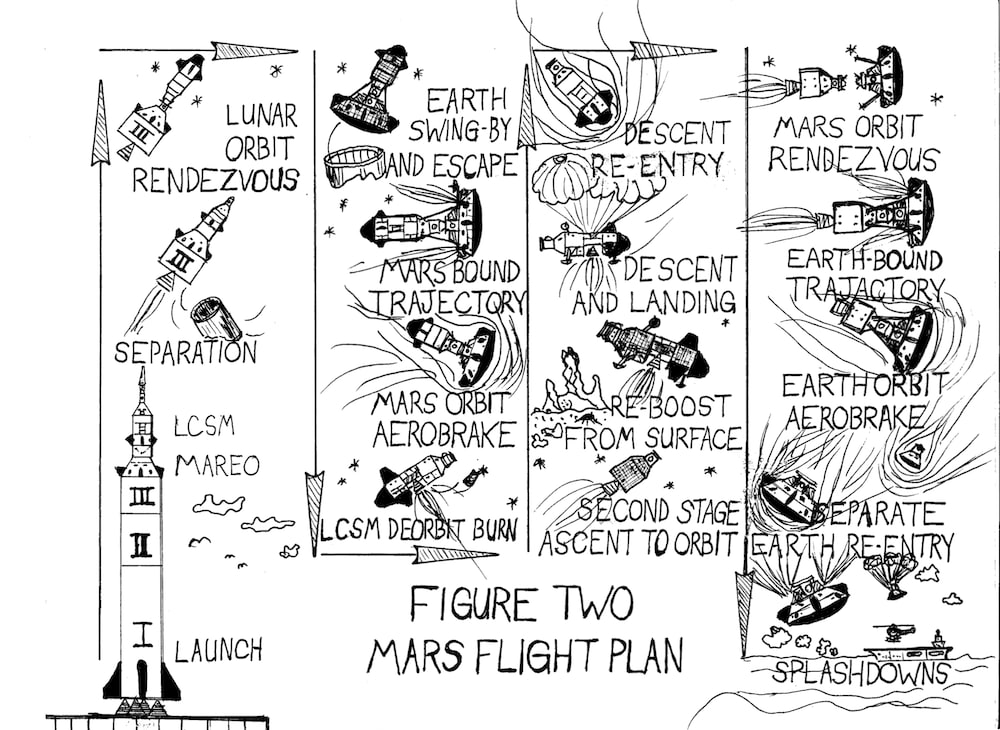The Mars Aeroshell Resource Orbiter (MAREO) combines habitation, storage, propulsion and aerobraking functions in one large conical spacecraft (Figure One), for a streamlined Mars mission plan.
Orbiter: MAREO is twice the diameter of the NASA Orion spacecraft. External Bays of the cone house Main Engines, angled nozzles pointed forward and outward; as well as reserves of fuel, oxidant, water, oxygen and electrical capacity. Crew Cabin has two habitation decks, with underfloor storage, upright bins and consoles. An Airlock Tunnel is enclosed by an Upper Cone Shroud in four quadrants: twin sets of three Orion return parachutes, total six; an Instrument Pallet with swing out High Gain Antenna boom; an EVA Platform, with hand-holds, twin MMU Racks and EVA Hatch; outboard stabilizer struts, and bays for Robotic Arms. Body Mounted Solar Arrays cover most of the Main Cone, with Thermal Radiators bordering its base.
Launch: An all-cryogenic variant of the Saturn V rocket (33 feet in diameter) launches the entire Mission Stack from Earth. MAREO sits atop its Third Stage (Figure Two). An Adapter Ring supports a Lander Command and Service Module (LCSM). LCSM is derived from Orion (16 ½ feet in diameter), its Service Module having rear Descent and Boost Module (DBM) and forward Ascent Module (AM). SM has a blunt-tipped conical Reentry Shield (which houses a Mars Rover), and reversible Control Fins.
Spaceflight to Mars: Lunar Orbit Rendezvous is used after Earth departure: LCSM separates and docks nose to nose with MAREO. Saturn Third Stage inserts them into a Mars trajectory, via Earth swing-by, before falling to Earth. MAREO points its own High Temperature Heat Shield forward; its Main Engines now point aft. LCSM’s Reaction Control Motors and Control Fins synchronize with MAREO’s own. MAREO carries LCSM and crew of four to Mars orbit. Its large Heat Shield protects from oncoming micrometeoroids, and aerobrakes into the Martian upper atmosphere to decelerate to orbital speed: It forms a large bow wave around both spacecraft. Reversible Control Fins provide lift and control during reentry. Medium Temperature Thermal Protection layers shield spacecraft sides from hot gases that flow around them. Fuels may be transferred to MAREO to optimize center of gravity for aerobraking. Crew seats are moved into MAREO for aerobraking, crew lying on their backs. Seats moved back to LCSM for Mars landing.
Mars Landing: LCSM separates from MAREO, which is left on orbit in standby mode. Panels blow away to expose twin descent motor nozzles, to deorbit and reenter LCSM. Engines fire to make a powered horizontal landing on Mars, after parachute deceleration (Figure Three). Landing Legs deploy from wells under the SM. A Descent Stair deploys from CM’s Nose Airlock, revealing EVA Hatch. Pannier Mission Equipment Bays fold down from sides of the SM. LCSM ascends back to the orbiting MAREO: DBM first stage; AM second stage after nose pitch up.
Return to Earth: MAREO fires its Main Engines to return crew to Earth. MAREO and CM separately reenter Earth’s atmosphere for a parachute splashdown at sea.
Like this entry?
-
About the Entrant
- Name:Leonard J Holmin
- Type of entry:individual
- Software used for this entry:None
- Patent status:none








